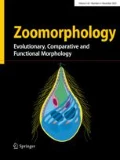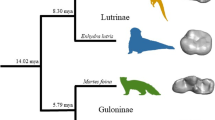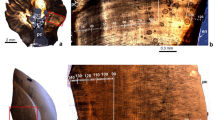Abstract
The relationship between tooth roots and diet is largely unexplored, although a logical relationship between harder diets and increased root surface area is suggested. Existing studies of primates, carnivorans and phyllostomid bats have indicated a relationship between diet hardness, bite force and tooth root surface area. The goal of this study was to determine whether root surface area can act as a potential surrogate for bite force and diet in cricetid rodents. Using microcomputed tomography (microCT), tooth root morphology from six species of rodents, two grass eaters (Calomys callosus and Reithrodon auritus), two seed eaters (Phyllotis darwini and Ochrotomys nuttalli) and two insect eaters (Akodon azarae and Oxymycterus hispidus) were compared. Similar to other studies, these rodents did exhibit differences in tooth root surface area based on diet classification, but food hardness did not seem to be a factor. Grass-eating species showed significantly larger roots relative to the other diet groups (p = 0.001). Bite force was estimated using skull measurements. Seed eaters were found to have a larger bite force, followed by grass and insect eaters, though the trend did not reach statistical significance (p = 0.058). No strong relationship was found between estimated bite force and tooth root surface area. In this study, the mechanics of grass eating seem to have a stronger effect on tooth root surface area than bite force. microCT allows the nondestructive quantification of previously difficult-to-access tooth morphology; this method shows the potential for tooth roots to provide valuable dietary, behavioral and ecological information in rodents.

Similar content being viewed by others
References
Barlow JC (1969) Observations on the biology of rodents in Uraguay. R Ont Mus 75:1–59
Christiansen P, Wroe S (2007) Bite forces and evolutionary adaptations to feeding ecology in carnivores. Ecology 88:347–358
Dalby PL (1975) Biology of pampa rodents. Mich State Univ Mus Publ Biol Ser 5:149–272
Dalby PL, Mares MA (1974) Notes on the distribution of the coney rat, Reithrodon auritus, in northwestern Argentina. Am Midl Nat 92:205–206
Diekwisch TGH (2001) The developmental biology of cementum. Int J Dev Biol 45:695–706
Druzinsky RE (1995) Incisal biting in the mountain beaver (Aplodontia rufa) and woodchuck (Marmota monax). J Morphol 226:79–101
Freeman PW, Lemen CA (2008) A simple morphological predictor of bite force in rodents. J Zool 275:418–422
Greaves WS (1988) The maximum average bite force for a given jaw length. J Zool 214:295–306
Hall ER (1981) The mammals of North America, 2nd edn. Wiley, New York
Kesner M (1980) Functional morphology of the masticatory musculature of the rodent subfamily Microtinae. J Morphol 165:205–222
Kupczik K, Dean MC (2008) Comparative observations on the tooth root morphology of Gigantopithecus blacki. J Hum Evol 54:196–204
Kupczik K, Stynder DD (2012) Tooth root morphology as an indicator for dietary specialization in carnivores (Mammalia: Carnivora). Biol J Linn Soc 105:456–471
Kupczik K, Le Cabec A, Hublin JJ (2010) Comparative morphology of incisor and molar roots in Neanderthals, middle pleistocene homo and homo sapiens. Am J Phys Anthropol 141(suppl 50):148–148
Martin T (1993) Early rodent incisor enamel evolution: phylogenetic implications. J Mamm Evol 1:227–254
Meserve PL (1981a) Resource patitioning in a Chilean semi-arid small mammal community. J Anim Ecol 50(3):745–757
Meserve PL (1981b) Trophic relationships among small mammals in a Chilean semiarid thorn scrub community. J Mammal 62:304–314
Naveh GRS, Brumfeld V, Shahar R, Weiner S (2013) Tooth periodontal ligament: direct 3D microCT visualization of the collagen network and how the network changes when the tooth is loaded. J Struct Biol 181:108–115
Nowak RM (1999) Walker’s mammals of the world, vol 1. The Johns Hopkins University Press, Baltimore
Pearson OP (1988) Biology and feeding dynamics of a south american herbivorous rodent, Reithrodon. Stud Neotrop Fauna Environ 23:25–39
Pizzimenti JJ, Salle R (1981) Factors influencing the distributional abundance of two trophic guilds of Peruvian cricetid rodents. Biol J Linn Soc 15:339–354
Reeder SA, Carroll DS, Edwards CW, Kilpatrick CW, Bradley RD (2006) Neotomine–peromyscine rodent systematics based on combined analyses of nuclear and mitochondrial DNA sequences. Mol Phylogenet Evol 40:251–258
Rensberger JM (1975) Function in the cheek tooth evolution of some hypsodont geomyoid rodents. J Paleontol 49(1):10–22
Sabat P, Bozinovic F (2000) Digestive plasticity and the cost of acclimation to dietary chemistry in the omnivorous leaf-eared mouse Phyllotis darwini. J Comp Physiol B 170:411–417
Samuels JX (2009) Cranial morphology and dietary habits of rodents. Zool J Linn Soc 156:864–888
Scaglia O, Velázquez C, Cauhepe M (1982) Plant composition of coney rat’s (Reithrodon auritus) diet. Acta Theriol 27:350–353
Self C (2015) Dental root size in bats with different dietary hardness. J Morphol (in revision)
Smole MS, Kleinschek K, Kreze T, Strnad S, Mandl M, Wachter B (2004) Physical properties of grass fibres. Chem Biochem Eng Q 18:47–54
Spencer M (1998) Force production in the primate masticatory system: electromyographic tests of boimechanical hypotheses. J Hum Evol 34:25–54
Spencer M (2003) Tooth-root form and function in platyrrhine seed-eaters. Am J Phys Anthropol 122:325–335
Springer SD, Gregory PA, Barrett GW (1981) Importance of social grouping on bioenergetics of the golden mouse, Ochrotomys nuttalli. J Mammal 62:628–630
Steppan S (1995) Revision of the tribe Phyllotini (Rodentia: Sigmondontinae), with a phylogenetic hypothesis for the Sigmodontinae. Revisión de la tribu Phyllotini (Rodentia: Sigmondontinae), con una hipótesis filogenética para los Sigmodontinae. Fieldiana Zool 1464:1–112
Stynder DD, Kupczik K (2012) Tooth root morphology in the early Pliocene African bear Agriotherium africanum (Mammalia, Carnivora, Ursidae) and its implications for feeding ecology. J Mamm Evol 20(3):1–11
Vincent JFV (1983) The influence of water content on the stiffness and fracture properties of grass leaves. Grass Forage Sci 38:107–114
Whishaw I, Sarna J, Pellis S (1998) Evidence for rodent-common and species-typical limb and digit use in eating, derived from a comparative analysis of ten rodent species. Behav Brain Res 96:79–91
Williams SH, Kay RF (2001) A comparative test of adaptive explanations for hypsodonty in ungulates and rodents. J Mamm Evol 8:207–229
Wroe S, McHenry C, Thomason J (2005) Bite club: comparative bite force in big biting mammals and the prediction of predatory behaviour in fossil taxa. Proc Biol Sci 272:619–625
Zioupos P, Casinos A (1998) Cumulative damage and the response of human bone in two-step loading fatigue. J Biomech 31:825–833
Acknowledgments
This work could not be done without museum collections and staff; specimens were kindly loaned from the University of Washington Burke Museum (UWBM) and the Museum of Vertebrate Zoology (MVZ) at the University of California, Berkeley. Jeff Bradley (UWBM) and Chris Conroy (MVZ) were especially helpful to this project. Tim Cox and Murat Maga at the Small ANimal Tomographic Analysis facility (SANTA) at Seattle Children’s Hospital provided training and assistance with CT scanning, for which I am grateful. Two anonymous reviewers greatly helped improve this manuscript. Many thanks to my advisor, Sue Herring, for her guidance and patience. This project was supported by T32 DE07132 from NIDCR.
Conflict of interest
The author has no conflict of interest to declare.
Ethical standard
This article does not contain any studies with human participants or animals performed by the author.
Author information
Authors and Affiliations
Corresponding author
Additional information
Communicated by A. Schmidt-Rhaesa.
Rights and permissions
About this article
Cite this article
Self, C.J. Cricetid rodents: Is molar root morphology an indicator of diet?. Zoomorphology 134, 309–316 (2015). https://doi.org/10.1007/s00435-015-0262-y
Received:
Revised:
Accepted:
Published:
Issue Date:
DOI: https://doi.org/10.1007/s00435-015-0262-y




